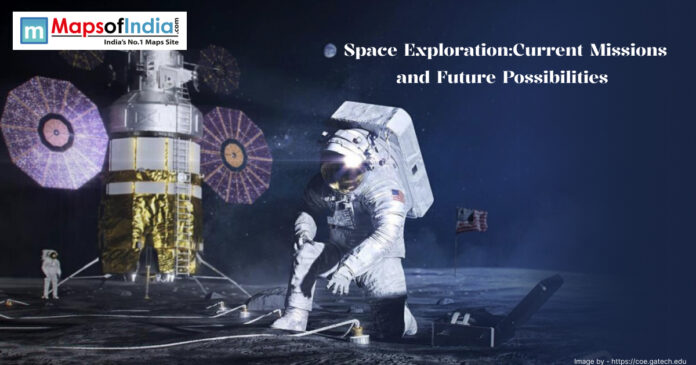The ambition to dominate the space has pushed the boundaries of what humans can dream of achieving. In recent years, many space missions launched by different organisations around the world have advanced our knowledge of the vast cosmos which is out there. Many government-owned space agencies are successful in gathering data about the cosmos. Private companies like SpaceX are also in this space race. According to the recent report of NASA, over 100 missions are planned worldwide. From Mars rovers to deep space probes, the innovative space missions are thriving. Future possibilities, including manned Mars landings and asteroid mining, are within the human range. According to the Planetary Society article, by the space agencies around the world, 20 major missions are planned.
Current Lunar Missions and Artemis Program
The focus of this year’s space missions is the Moon. NASA’s Artemis II is set to launch in September. This is the first crewed mission to the Moon since Apollo. Four astronauts will orbit the Moon. A NASA press release says it tests the Orion spacecraft for 10 days. After that, Artemis III followed in 2026 for landing. China has also launched its mission Chang’e-6 to sample the far side of our galaxy in 2024. The next big mission of China is Chang’e-7, which plans to conduct polar exploration in 2026. This mission will be done in international collaboration. India‘s most ambitious moon mission, Chandrayaan-4, is also planning to return to Earth after collecting samples from the moon in 2027. This mission will focus on the lunar south pole. Commercial missions like Intuitive Machines’ IM-2 target ice in 2025. This mission will try to drill for water. Lunar missions have built a sustainable presence. These missions will pave the way for habitats.
Mars Exploration and Robotic Rovers
There are many Mars missions planned each year to continue probing the red planet. The Perseverance rover was launched by NASA in 2021 and has been collecting samples from Mars. More than 43 sample tubes are filled to collect the data. The Mars Sample Return mission plans retrieval in 2028. According to the ESA report, this joint NASA-ESA mission has cost $11 billion. China has also targeted the red planet. The Tianwen-1 orbiter has been studying the atmosphere around Mars since 2021. Europe‘s ExoMars rover will be launched in 2028. This will drill 2 meters deep on the Mars surface. This mission is confirmed in the ESA timeline. The Hope orbiter launched by the UAE has been mapping the weather on Mars since 2021. This orbiter has completed 3 Martian years. Mars missions uncover habitability clues. They inspire future human landings.
Deep Space Probes and Planetary Flybys
There are many missions launched to explore Deep space; these missions venture beyond. The EUA’s most recent satellite, BepiColombo, flies by Mercury in January 2025. This will try to study the planet’s core. According to the ESA press release says six flybys are planned before the 2025 orbit. NASA’s Europa Clipper was launched in October 2024. This satellite will arrive at Jupiter in 2030. It probes Europa’s ocean. According to the recent NASA report, more than 50 flybys are planned in the coming years. Japan‘s Martian Moons eXploration (MMX) will be launched in 2026 into deep space to collect a sample of Phobos. These collected samples will return to Earth by 2031. To explore the asteroid belt, NASA is planning to launch the Psyche mission by 2029. This mission will explore the metal core in the belt.
Human Spaceflight and International Space Station
Thai year, humans were able to achieve Human (civilian) spaceflight. NASA’s SpaceX Crew-10 was docked in the ISS this March. ISS operates until 2030. China’s Tiangong station hosts three taikonauts. Shenzhou-19 will be launched this year. A CNSA timeline notes these will be year-long missions. India’s Gaganyaan plans an uncrewed test this year. Crewed flight will follow in 2026. According to the ISRO statement says three astronauts will go to space for three days. Private missions like Axiom-4 visit ISS. American music sensation ketty perry also visited ISS. Human spaceflight expands knowledge. It tests long-duration tech for Mars.
Private Sector Involvement and Space Tourism
Private companies are now leading the innovation in the space. SpaceX’s Starship is set to launch for Mars in 2025. A SpaceX update says orbital refuelling demos. Blue Origin’s New Glenn mission is planning to launch in late 2025. This mission will carry 45 tons to the outer orbit. Virgin Galactic’s space tourism has resumed. According ot the Virgin report, monthly flights will cost at least $450000 per seat. The first indian space tourist will go to the ISS in Axiom Space’s private ISS mission in 2025. A recent Axiom announcement confirms this. Boeing’s Starliner crews to ISS. The private sector cuts costs by 50%. According to the Space Economy report says the space tourism market will be $1 trillion by 2040. Tourism and commercial stations grow.
Scientific Discoveries and International Collaboration
Space missions are the breakthrough steps for future innovations. NASA’s James Webb Telescope observes exoplanets. This telescope has detected water vapour on 20 different worlds. To study the moon of Jupiter, ESA has launched a mission called JUICE in 2023. Till 2031, this mission is expected to reach Jupiter’s moon. This mission is planning to study icy moons that surround Jupiter. An ESA update notes Ganymede focus. India to study the Sun has launched the Aditya-L1 mission in 2023. In 2024, this mission entered Sun’s L1 orbit. Collaboration with different space agencies is important it shares the necessary knowledge with other agencies and helps to develop the technology. The collaborative satellite NISAR, developed by ISRO-NASA, is a radar satellite that will be launched in 2025. This satellite will map Earth’s changes. A 2024 NASA partnership article notes 3-meter resolution. Discoveries like lunar water from Chandrayaan-1 in 2009 inspire. Collaboration of different nations in space missions will accelerate scientific innovations.
Conclusion
From the time space exploration started, it has faced many hurdles. Not having a proper budget to have a proper space mission is one of the largest challenges faced by many agencies. This year’s funding received by ISRO is Rs. 13000 crore. This budget is less than 0.25% of the nation’s GDP. Technical failures like Chandrayaan-2’s 2019 crash occur for every nation. A recent report by ESA says 36500 objects orbit Earth. International treaties are needed to maintain order in the space race. Soon, it will be possible to have manned Mars missions by the 2030s. NASA’s Artemis base in 2028 enables this. Asteroid mining for resources is also growing. A recent report says it will generate $100 quintillion in metals. Space tourism is expected to grow to $9 billion by 2030. Challenges are also the inspiration for innovation. The future holds interstellar dreams.





